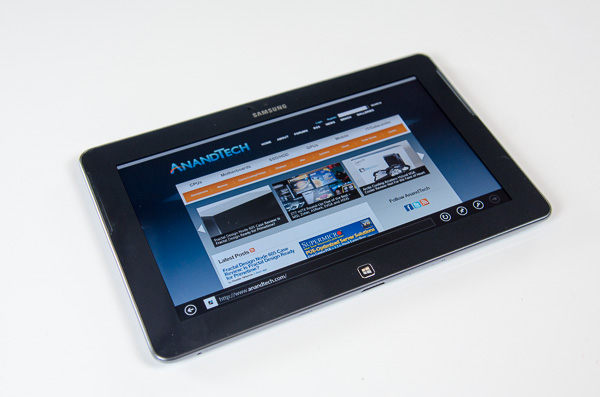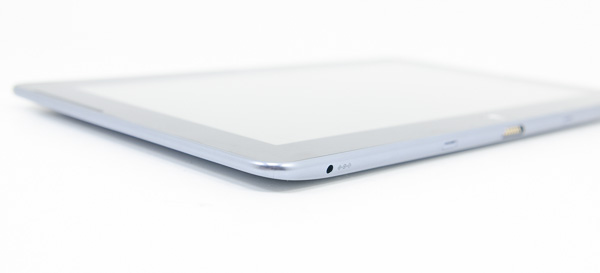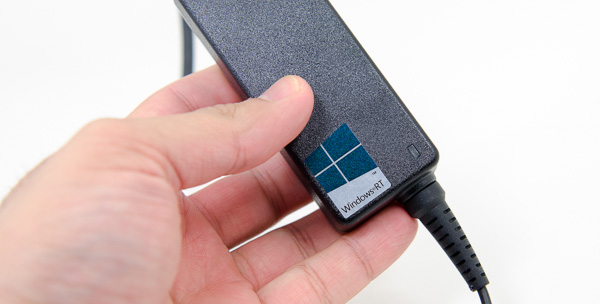Samsung ATIV Tab Review: Qualcomm's First Windows RT Tablet
by Anand Lal Shimpi on January 3, 2013 6:00 AM EST- Posted in
- Tablets
- Samsung
- Qualcomm
- Mobile
- Windows RT
Final Words
With better battery life than Surface RT and better performance as well, I have to say that in the ARM camp Qualcomm's APQ8060A is definitely the preferred SoC for Windows RT today. Qualcomm's single threaded performance advantage is obvious in interacting with the ATIV Tab, particularly for any work on the desktop (modern UI remains fairly smooth across all platforms). Application performance and web browsing performance are at worst equal to NVIDIA's Tegra 3, but at best are tangibly better. Intel continues to have the overall performance advantage (not to mention backwards compatibility), but at times Qualcomm remains surprisingly competitive in many of our tests.
Ultimately even Atom isn't quick enough to fulfill the dream of having a tablet that can really replace a modern notebook, and that's where the Windows RT/8 cookie crumbles for now. I suspect that once we get to the next generation of SoCs we'll see a better story from all of the vendors (22nm Atom, Cortex A15 based Wayne, Krait 200/300 from Qualcomm).
The ATIV Tab itself feels fairly well executed. Its performance is snappy (for Windows RT) and unlike my W510 experience, I didn't encounter much instability during my use of the Tab. Battery life is better than any other Windows RT or 8 tablet we've tested thus far. The Samsung/Qualcomm combination excels in video playback battery life in particular, giving us the first 10-inch tablet capable of lasting as long as a modern iPad in our video playback test. Web browsing battery life is also quite competitive, equaling the Clover Trail based Samsung ATIV Smart PC.
The 10.1-inch form factor and light weight construction make the ATIV Tab a device I wouldn't mind carrying around. Camera quality unfortunately isn't very good overall, particularly in low light situations. Thankfully, unlike most other Windows RT/8 devices we've tested thus far, the ATIV Tab does a great job when it comes to WiFi performance - equaling competitors from Apple and Google. Display quality is competitive with other Windows RT/8 tablets, but it does lag behind the iPad 3/4. If you absolutely need to buy a Windows RT tablet today and value performance more than design/build quality, the ATIV Tab isn't a bad option.
Although I like the ATIV Tab, I still feel like Windows RT/8 and the first generation of tablets need another iteration before they're truly ready for duty. I'd love to see the Surface team's industrial design paired with a faster SoC, a lighter chassis and a more cohesive OS. Windows RT/8 still feel rushed to me (for reasons I've explained before), let's hope that Windows Blue ships on time this year and delivers a more polished and complete experience.













42 Comments
View All Comments
kyuu - Thursday, January 3, 2013 - link
"I suspect that once we get to the next generation of SoCs we'll see a better story from all of the vendors (22nm Atom, Cortex A15 based Wayne, Krait 200/300 from Qualcomm)."You seem to have forgotten about AMD's upcoming Temash tablet SoC. That's the one I'm looking forward to the most. Heck, I'd take the AMD's Hondo Z-60 over Clover Trail even today, if there were any tablets actually using it.
mayankleoboy1 - Thursday, January 3, 2013 - link
40nm Temash will be power hungry. It will probably have great GPU performance, but the battery life will be crappy. There is a limit on how many transistors you can add on 40nm. :(Death666Angel - Thursday, January 3, 2013 - link
Anandtech said they will be 28nm, so unless things have changed (in which case a link would be nice) they should be competitive.OoklaTheMok - Thursday, January 3, 2013 - link
Anand, the way you mentioned lack of a rotation lock on the ATIV Tab seems to indicate that there isn't a way to lock the screen rotation. Rotation lock is controlled via software @ Charms Bar > Settings > Screen. You likely know this already, but other readers may come away thinking that Win 8/RT lacks a rotation lock.Thank you for your great review as usual. I always love the details you provide.
powerarmour - Thursday, January 3, 2013 - link
So where are the Adreno GPU tests?, how do the drivers perform in DirectX...Talk about half a review!
Ananke - Thursday, January 3, 2013 - link
Anything that cost equal or more than iPad is a marketing joke, and it wont sell well - it is that simple. I don't like Apple products at all, but once considering all the available applications, accessories, future support by even more applications, etc. there is no reason to spend the same money on something else than iPad. For the non-i fans there is Android already.RT is already dead dog, for retail. It did have its several months of prime time, but the time is gone now...
Saying all of this while owning MS W8 desktops, laptops, and phones.
My ex-MS developer friends, that are now all Android developers, say they no more are interested or intend to move back to MS - it is just not worth developing for a very limited user base. Overpricing of RT doesn't help either.
Visual - Thursday, January 10, 2013 - link
It will sell if it runs Crysis.ImSpartacus - Thursday, January 3, 2013 - link
Page 2"This test uses using AES for security."
MonkeyPaw - Thursday, January 3, 2013 - link
How is it when I run Kraken on my TF700T running Jelly Bean and Chrome, I score 22053? Is it hardware, Android or Chrome making the difference? That handily defeats all the Windows 8 tablets unless I'm missing something.Klimax - Friday, January 4, 2013 - link
Benchmark specific optimisation in Chrome most probably. (After SunSpider IE team apparently stopped paying attention to them) Also those benches are often written by browser vendors themselves and for their internal usage and thus originally targeted at their own browser reducing value of that for other browsers. (Testdrive, Kraken, Octane,...)BTW: Comment form doesn't post under IE10 with compatibility mode off.